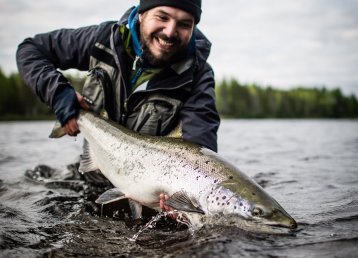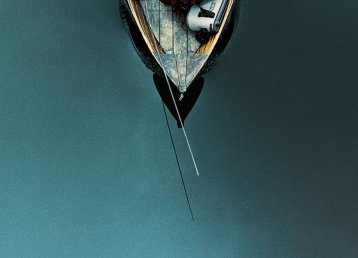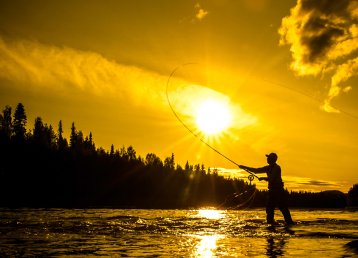It is an unusual sight. From the helicopter we can see Lake Pieskehaure, below the Sulitelma massif, lying almost completely still. Only a few ripples move across the surface of the large body of water. Pilot Emil Sundberg says it looks like we chose a good time to come, then he smiles and takes us on a sightseeing tour across the largest glacier in Sweden, the origin of the entire Pite river. There are so many things involved in mountain fishing. If you interview mountain fishers, they speak of friendship, nature and tranquillity. Only rarely do they approach the heart of the matter: if the weather is good, the fishing is good. The mountains give, and the mountains take away – praised be the nature of the mountains! A severe three-day storm from the west that makes the mountain birch bend low towards the ground is nothing unusual. A heatwave in early June causing the meltwater to flood the forest is more unusual, but it happens. A heatwave later in the year, making the hatching dry up and stop, is not unusual though. It is just a shame you were not there when it happened. Not every day in the world of trout is a feeding frenzy, but to us who fish for them, it might be. The weather is that part of a mountain trip you can never control. Especially since you booked the trip at some point during winter when your fishing abstinence peaked, and there was no way of resisting the urge. As the trip approaches, you follow the weather forecast like a believer follows a guru.
At the office
Emil Sundberg on an ordinary working day in the mountains. In so many ways, and for numerous reasons, the helicopter is essential to the area.
A bit like cooking
— You could say it is a bit like cooking, says chef Johan Eriksson from Piteå when asked how difficult mountain fishing is, and what luck has to do with it.
— In cooking, you can minimise the amount of luck needed by choosing the right ingredients and cooking methods. You can minimise the fishing luck dependency by choosing the right place and fishing methods.
— If you know what you are doing, that tends to make it a lot easier, too.
Johan knows his cooking and does not need to fall back on his luck. If you were once the head chef of a restaurant with two Michelin stars, it is not because you are lucky. Instead, it is because you understand the importance of keeping the same standard every time a plate is carried to a table. Johan fishing in Miekak right now simply comes down to experience: he knows it is a good ingredient.
It is called the ‘central current’, in the Pieskehaure current, and it is part of every fly fisher’s dream. Classic spots like ‘the Dragon’s Back’ and the outlet in Lill-selet sometimes provide biting trout that weigh several kilos, allowing people to survive the harshest winters just by dreaming of coming back. I lost my biggest-ever Arctic char here, almost 20 years ago. I still look down from the same spot, scouting the water to see if perhaps it is still there. But there is neither char nor luck here today. The hatching carries on in the central current though, and the big trout get bigger. You will not catch a fish every time you cast, but with several casts you do, and what is nice about it is that it lasts all day. Every fisher thinks that this kind of day must come to an end. No way will the wind be absent and the trout bite everywhere for an entire day. Still, that is the case today. The biggest trout Johan gets is 56 centimetres and in good condition. Then he gets a dozen other fish around 50 centimetres. All of them using a dry fly. The fact that they bite flies he serves up on the surface is the most beautiful part of fly fishing, as far as he is concerned. In many ways, it is what makes him feel like a happy person today.
Star chef
When Johan was a teenager, he was offered the opportunity to start working at the restaurant Noma in Copenhagen. For many years, many have considered Noma the best restaurant in the world. In a way, it is the reason why the world discovered the new Nordic cuisine. But Copenhagen was not Johan’s cup of tea, so he moved north, to the restaurant boat Oaxen in Stockholm. After a couple of years, he was made head chef there, and after a while, they got their first star in Guide Michelin. After another couple of years with Johan as head chef, Oaxen received its second star. But neither Stockholm nor stars were Johan’s cup of tea, so he moved back home to Piteå, and after a while, he started a pizzeria in his hometown.
— I know, a pizzeria might not sound like much. But honestly, I learnt the more about a kitchen there that I’ve learnt in many years.
— Making a pizza using sourdough is difficult; every day you have to look after the dough. The mood of the dough keeps changing from one day to the next.
— No one could have as many mood swings as a sourdough. It reacts to all kinds of humidity and weather changes – it’s worse than an old man with bad knees.
— It’s bloody difficult, making tasty pizzas. But it was very good for me.
Choosing something else
Johan Eriksson did not move back home to Piteå to feed a sourdough, however. He might be running a new bistro called Centrum Krog there days, but the real reason was that he wanted to go fishing.
— At Noma and Oaxen, I had time for one week of mountain fishing per year. If you’re used to or want to, go fishing more than one week per year, it’s so difficult, he says.
— Well, you can imagine what Johan’s mood was like after an unsuccessful fishing week, Johan’s fishing buddy John Lind adds.
— The atmosphere in the car was pretty bad, you know, coming back from the mountains and he was flying down to Stockholm and me, and the others were talking about our next fishing trip with him knowing it would be a year until next time.
— He’d look so depressed.
John and Johan have known each other since they were kids. They have been fishing together for a long time and every summer they go on trips together.
— It’s a luxury, having a skilled chef come along. We never eat anything freeze-dried, says John in the evening as we sit down to celebrate the day.
Then he indicates the fireplace and the pieces of tenderloin that Johan is barbecuing down by Alep Miekak.
— The only promise I have given Johan is that I will carry all the food we need here on the mountain, as long as he cooks it, Johan continues with a laugh.
A trout on a shoulder
John is the Swedish Ice Hockey Association’s education manager. He knows a lot about passion and has seen many follow their dreams. When he was thirteen, he wanted to shave his hair off. People on the team thought it was fashionable. His mother, who loved John’s hair, became desperate and promised him a tattoo if he didn’t do it. All said and done, John’s mother had to take him to the tattoo studio, and since then, he has had a trout on his shoulder.
— If you’re a young chef and get the opportunity to work at Noma, you’ll probably not say no. It’s like an ice-hockey player being drafted to the NHL. But what’s special about Johan is that he discovered that the ‘NHL-thing’ was not his thing.
— It’s not always the case that people understand who they are, and what they really want to do, and then go on to do exactly that.
— Well, this year we have gone fishing in the mountains four times. Perhaps we can squeeze in one more, that would be absolutely wonderful, says Johan and smiles contentedly.
About as contentedly as we will be smiling as we sink our teeth into that tenderloin that has been moved from the barbecue onto the plate. It tastes like a successful fishing trip. Perfect.
More than 30 years
In Miekak Johan and John also go fishing with Thomas Wennberg. This is his 31st season here. It is not like he comes here for a few days – he comes here for a few weeks. This year it will be nearly a month.
— I had basically just learnt to cast a fly when a friend asked if I wanted to go fishing in Miekak.
— Somehow, the place settled in my heart, and my brain. You know, every winter I think it might have been the last season here, but then you’re lucky, and there’s another one.
— I have good fishing down in Idre where I live, and perhaps it should be enough. But it’s like something would still be missing inside of me if I didn’t come here.
But 31 years? It is a hell of a lot. Do you never get bored?
— Haha, no, apparently not. But jokes aside, there’s so much variety here and so many challenges that you discover something new every single year.
— It’s actually true as they say: a river is never the same. It never repeats itself. This one has become like an addiction.
It was Roderick Haig-Brown who wrote that a river never sleeps. Surely that is just the way it is. Or as TS Elliot wrote – which can also be translated to fishing, and all our human dreams and discoveries – part of the goal is to arrive where we started our journey, to look at the place as if we saw it for the first time.
Fishing luck
Next day, my choices are running up to the central current again or go to the Låddaure current and try my luck there. I go for Låddaure, mostly because some of the mountain world’s most beautifully patterned trout are allegedly found there. But just like Thomas, who after 31 years have learnt the hard way that a current or a fishing spot is never the same as it was yesterday, Johan and John will also learn that it is the fish, not the fisher, that plays the deciding role in the game of chance we refer to as fishing luck. It is difficult fishing, to say the least, and even if some large trout are visible, they are not cooperative. By lunchtime, we are not completely empty-handed, but there are not as many as there was yesterday. However, the Låddaure current is incomparably beautiful, and Thomas tells us some nice fishing stories about trout 60 centimetres long with crimson dots along the side, shining like precious gems. Johan is on his knees by the camping stove, frying gurpi and black pudding made by a friend of his. When I am offered a taste, I think it is such a great thing that one of us came up with what he really wanted to do in life. Because, the way I see it, in the frying pan, it means I will get a couple more pieces. And this is really damn good. Then I see how Thomas manages to hook a nice trout.
Learn more
Miekak Hunting and Fishing is located in the Arjeplog mountains, where you can fish for trout, brown trout and grayling. To learn more about Miekak, and to make a reservation, go to miekak.com.




































